Negotiation Strategies and Contracts
VerifiedAdded on 2020/05/04
|17
|4451
|148
AI Summary
This assignment delves into the complexities of negotiation strategies and contract management. It examines various approaches used in diverse contexts, including construction and alternative food networks. The analysis covers topics such as supplier negotiations, service-level agreements (SLAs) in cloud computing, terms-of-trade effects in trade agreements, and ethical considerations in business models. The assignment also touches upon dispute resolution mechanisms and the influence of female world leaders in collaborative negotiation.
Contribute Materials
Your contribution can guide someone’s learning journey. Share your
documents today.
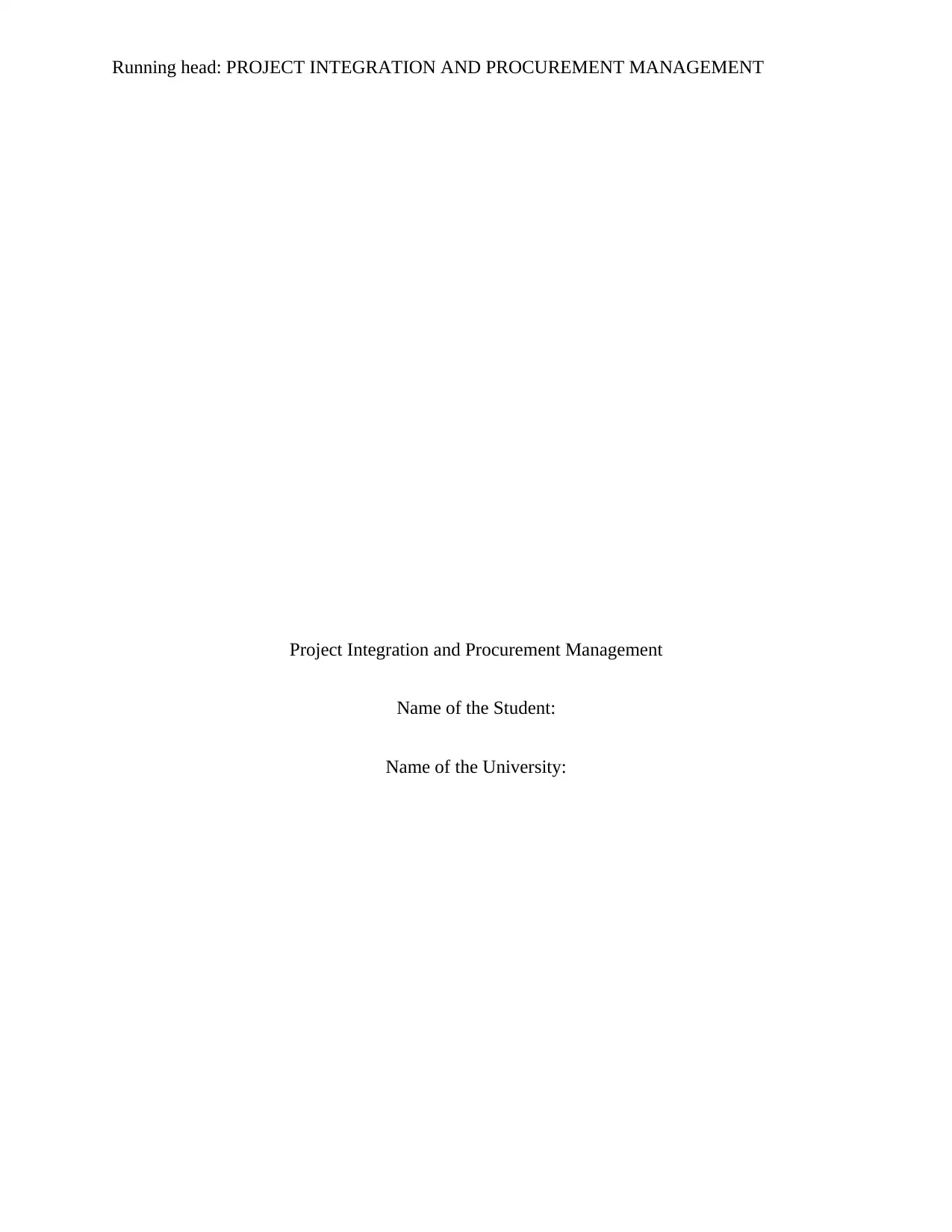
Running head: PROJECT INTEGRATION AND PROCUREMENT MANAGEMENT
Project Integration and Procurement Management
Name of the Student:
Name of the University:
Project Integration and Procurement Management
Name of the Student:
Name of the University:
Secure Best Marks with AI Grader
Need help grading? Try our AI Grader for instant feedback on your assignments.
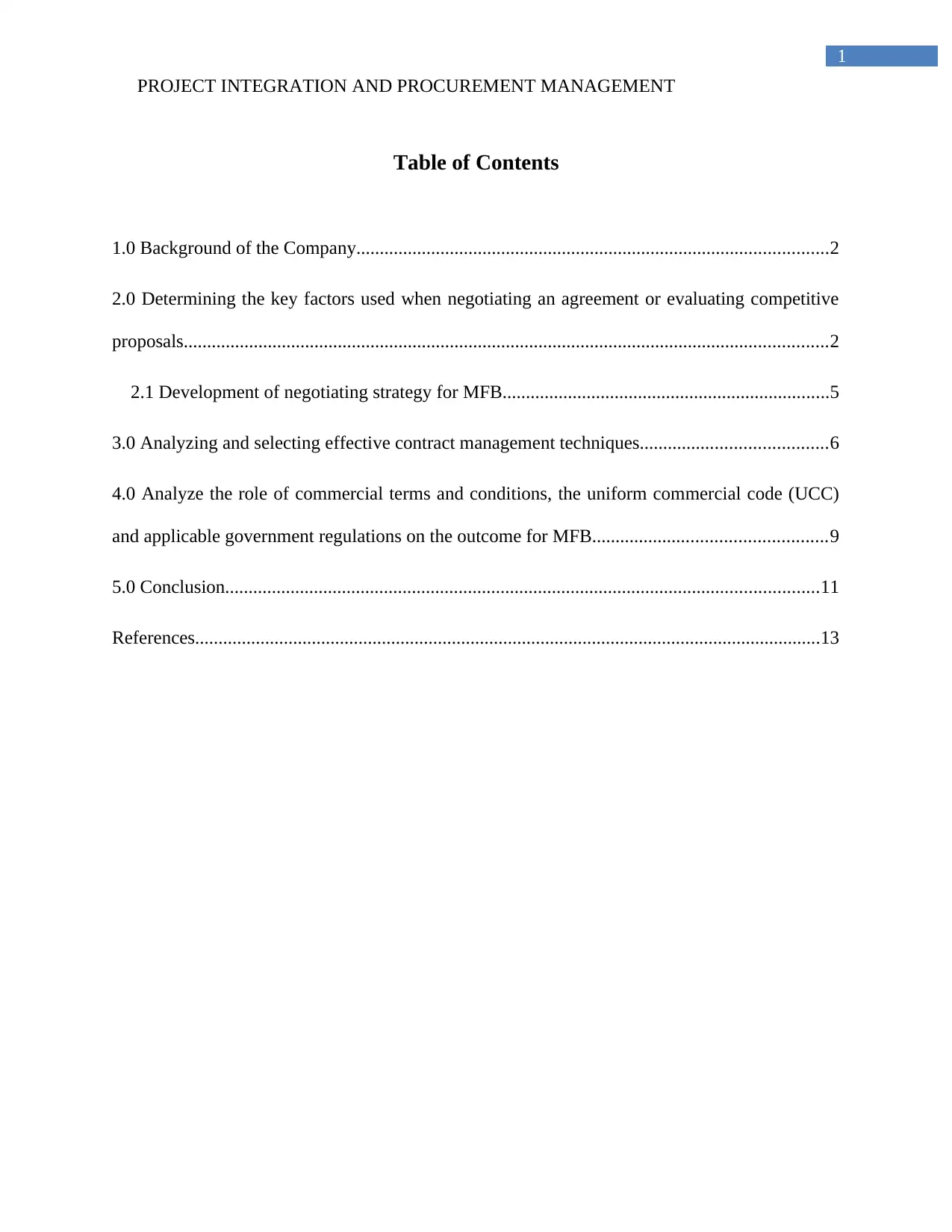
1
PROJECT INTEGRATION AND PROCUREMENT MANAGEMENT
Table of Contents
1.0 Background of the Company.....................................................................................................2
2.0 Determining the key factors used when negotiating an agreement or evaluating competitive
proposals..........................................................................................................................................2
2.1 Development of negotiating strategy for MFB......................................................................5
3.0 Analyzing and selecting effective contract management techniques........................................6
4.0 Analyze the role of commercial terms and conditions, the uniform commercial code (UCC)
and applicable government regulations on the outcome for MFB..................................................9
5.0 Conclusion...............................................................................................................................11
References......................................................................................................................................13
PROJECT INTEGRATION AND PROCUREMENT MANAGEMENT
Table of Contents
1.0 Background of the Company.....................................................................................................2
2.0 Determining the key factors used when negotiating an agreement or evaluating competitive
proposals..........................................................................................................................................2
2.1 Development of negotiating strategy for MFB......................................................................5
3.0 Analyzing and selecting effective contract management techniques........................................6
4.0 Analyze the role of commercial terms and conditions, the uniform commercial code (UCC)
and applicable government regulations on the outcome for MFB..................................................9
5.0 Conclusion...............................................................................................................................11
References......................................................................................................................................13
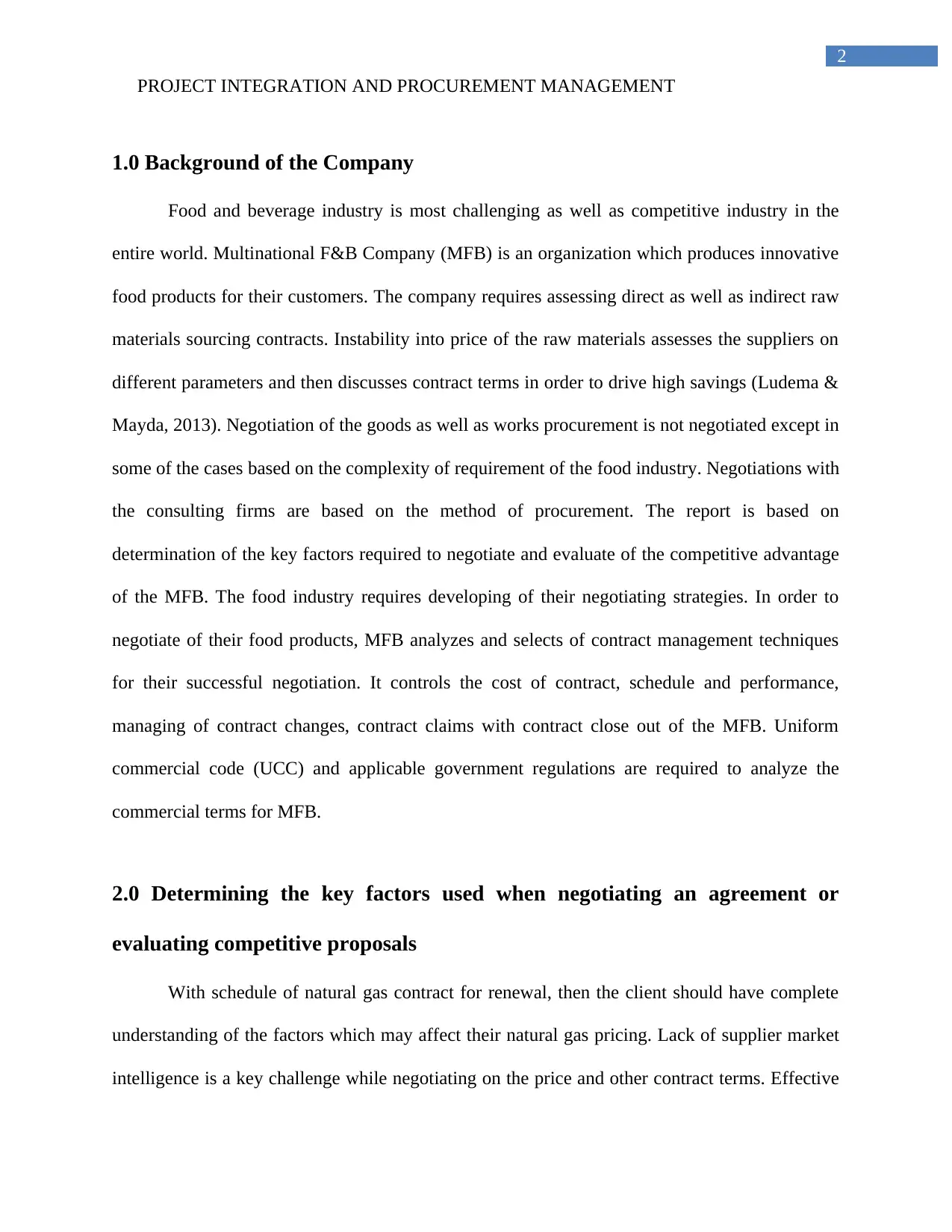
2
PROJECT INTEGRATION AND PROCUREMENT MANAGEMENT
1.0 Background of the Company
Food and beverage industry is most challenging as well as competitive industry in the
entire world. Multinational F&B Company (MFB) is an organization which produces innovative
food products for their customers. The company requires assessing direct as well as indirect raw
materials sourcing contracts. Instability into price of the raw materials assesses the suppliers on
different parameters and then discusses contract terms in order to drive high savings (Ludema &
Mayda, 2013). Negotiation of the goods as well as works procurement is not negotiated except in
some of the cases based on the complexity of requirement of the food industry. Negotiations with
the consulting firms are based on the method of procurement. The report is based on
determination of the key factors required to negotiate and evaluate of the competitive advantage
of the MFB. The food industry requires developing of their negotiating strategies. In order to
negotiate of their food products, MFB analyzes and selects of contract management techniques
for their successful negotiation. It controls the cost of contract, schedule and performance,
managing of contract changes, contract claims with contract close out of the MFB. Uniform
commercial code (UCC) and applicable government regulations are required to analyze the
commercial terms for MFB.
2.0 Determining the key factors used when negotiating an agreement or
evaluating competitive proposals
With schedule of natural gas contract for renewal, then the client should have complete
understanding of the factors which may affect their natural gas pricing. Lack of supplier market
intelligence is a key challenge while negotiating on the price and other contract terms. Effective
PROJECT INTEGRATION AND PROCUREMENT MANAGEMENT
1.0 Background of the Company
Food and beverage industry is most challenging as well as competitive industry in the
entire world. Multinational F&B Company (MFB) is an organization which produces innovative
food products for their customers. The company requires assessing direct as well as indirect raw
materials sourcing contracts. Instability into price of the raw materials assesses the suppliers on
different parameters and then discusses contract terms in order to drive high savings (Ludema &
Mayda, 2013). Negotiation of the goods as well as works procurement is not negotiated except in
some of the cases based on the complexity of requirement of the food industry. Negotiations with
the consulting firms are based on the method of procurement. The report is based on
determination of the key factors required to negotiate and evaluate of the competitive advantage
of the MFB. The food industry requires developing of their negotiating strategies. In order to
negotiate of their food products, MFB analyzes and selects of contract management techniques
for their successful negotiation. It controls the cost of contract, schedule and performance,
managing of contract changes, contract claims with contract close out of the MFB. Uniform
commercial code (UCC) and applicable government regulations are required to analyze the
commercial terms for MFB.
2.0 Determining the key factors used when negotiating an agreement or
evaluating competitive proposals
With schedule of natural gas contract for renewal, then the client should have complete
understanding of the factors which may affect their natural gas pricing. Lack of supplier market
intelligence is a key challenge while negotiating on the price and other contract terms. Effective

3
PROJECT INTEGRATION AND PROCUREMENT MANAGEMENT
negotiation helps the organization to build stable business relations, overcome with the conflicts
with the suppliers and bring more income to the company (Carneiro et al., 2013). MFB Company
saves of millions in their sourcing of energy throughout GEP market intelligence. The global
energy experts of GEP help the client to determine the supplier of natural gas and negotiate of
agreement. MFB wants to negotiate based on the factors such as time of delivery, payment,
culture and quality of the goods (Merrills, 2017). The food and drink industry views good deal
for meeting with the customer’s requirements. Following are the list of key factors used at the
time of negotiation of the agreement:
Price: Before the negotiating of the agreement, the food industry should require to get the
price list of the products from the suppliers. It is required to calculate the cost of each product
from the supplier separately. When the price is low, then the organization should check for the
quality of the food and drink (Li & Du, 2013). If MFB is a premium customer of the supplier,
then they ask for huge discount to get best deal of the food items.
Quality: It is required to do a basic research about the potential supplier to get an idea of
the quality of services they offer to their customers. It should make sure that the suppliers have
cash flow to deliver quality food products as per customer’s requirements (Amorim et al., 2016).
Proper time to make an agreement with the supplier is also important which should be in end of
the month. The sales person is needed to meet monthly sales quota. The contract administration
should ensure for day to day procurement of the activities by following the sprint. Improvement
into the procurement environment means there is greater efficiency and there is increase into
profit.
PROJECT INTEGRATION AND PROCUREMENT MANAGEMENT
negotiation helps the organization to build stable business relations, overcome with the conflicts
with the suppliers and bring more income to the company (Carneiro et al., 2013). MFB Company
saves of millions in their sourcing of energy throughout GEP market intelligence. The global
energy experts of GEP help the client to determine the supplier of natural gas and negotiate of
agreement. MFB wants to negotiate based on the factors such as time of delivery, payment,
culture and quality of the goods (Merrills, 2017). The food and drink industry views good deal
for meeting with the customer’s requirements. Following are the list of key factors used at the
time of negotiation of the agreement:
Price: Before the negotiating of the agreement, the food industry should require to get the
price list of the products from the suppliers. It is required to calculate the cost of each product
from the supplier separately. When the price is low, then the organization should check for the
quality of the food and drink (Li & Du, 2013). If MFB is a premium customer of the supplier,
then they ask for huge discount to get best deal of the food items.
Quality: It is required to do a basic research about the potential supplier to get an idea of
the quality of services they offer to their customers. It should make sure that the suppliers have
cash flow to deliver quality food products as per customer’s requirements (Amorim et al., 2016).
Proper time to make an agreement with the supplier is also important which should be in end of
the month. The sales person is needed to meet monthly sales quota. The contract administration
should ensure for day to day procurement of the activities by following the sprint. Improvement
into the procurement environment means there is greater efficiency and there is increase into
profit.
Secure Best Marks with AI Grader
Need help grading? Try our AI Grader for instant feedback on your assignments.

4
PROJECT INTEGRATION AND PROCUREMENT MANAGEMENT
Delivery schedule of the ordered goods: When MFB signs contract with the supplier,
then it should require making sure that the supplier deliver the ordered goods on time. Therefore,
it should be ensured that delivery time schedule is mentioned into the agreement properly
(Sebastiani, Montagnini & Dalli, 2013). It is also required to ask the suppliers about their
transport channel. Therefore, it is ensured that the products are delivered on scheduled time.
Transport of the packaging: It should be logical that the supplier with each of the
delivery of the ordered products drove left returnable packaging. Therefore, a clear agreement
should be done to agree with the supplier for transportation of packaging (Dixon, 2015). If the
supplier is adhere to their agreement, then call the delivery chief and show them about the
problems.
Culture: In different country there is different culture, therefore the process of
negotiation is also different. The factors which are required to focus on are physical contract with
the supplier, physical distance, eye contact and others (Bailey & Garforth, 2014). Even they have
different attitude which makes a lot of difference in negotiation.
In the challenging environment, the food player is forced to select, source and manage of
their products. MFB should of innovative ways to reduce their total cost and unlock of hidden
values of their raw materials. It allows the food company to keep 2-6 percent of the cost of direct
materials (Kajzer Mitchell et al., 2017). It also saves 8-22 percent of cost of conversion. In order
to make improvement into 1 percent of the direct materials cost, MFB can improve the net
margin by 200-300 basis points. Contracting plan for MFB supports the procurement approach of
their negotiation (Dong, 2016). The factors chosen are uncertainty of the scope of work required,
other party assumed of risk due to increase into unexpected cost, importance of meeting to
PROJECT INTEGRATION AND PROCUREMENT MANAGEMENT
Delivery schedule of the ordered goods: When MFB signs contract with the supplier,
then it should require making sure that the supplier deliver the ordered goods on time. Therefore,
it should be ensured that delivery time schedule is mentioned into the agreement properly
(Sebastiani, Montagnini & Dalli, 2013). It is also required to ask the suppliers about their
transport channel. Therefore, it is ensured that the products are delivered on scheduled time.
Transport of the packaging: It should be logical that the supplier with each of the
delivery of the ordered products drove left returnable packaging. Therefore, a clear agreement
should be done to agree with the supplier for transportation of packaging (Dixon, 2015). If the
supplier is adhere to their agreement, then call the delivery chief and show them about the
problems.
Culture: In different country there is different culture, therefore the process of
negotiation is also different. The factors which are required to focus on are physical contract with
the supplier, physical distance, eye contact and others (Bailey & Garforth, 2014). Even they have
different attitude which makes a lot of difference in negotiation.
In the challenging environment, the food player is forced to select, source and manage of
their products. MFB should of innovative ways to reduce their total cost and unlock of hidden
values of their raw materials. It allows the food company to keep 2-6 percent of the cost of direct
materials (Kajzer Mitchell et al., 2017). It also saves 8-22 percent of cost of conversion. In order
to make improvement into 1 percent of the direct materials cost, MFB can improve the net
margin by 200-300 basis points. Contracting plan for MFB supports the procurement approach of
their negotiation (Dong, 2016). The factors chosen are uncertainty of the scope of work required,
other party assumed of risk due to increase into unexpected cost, importance of meeting to
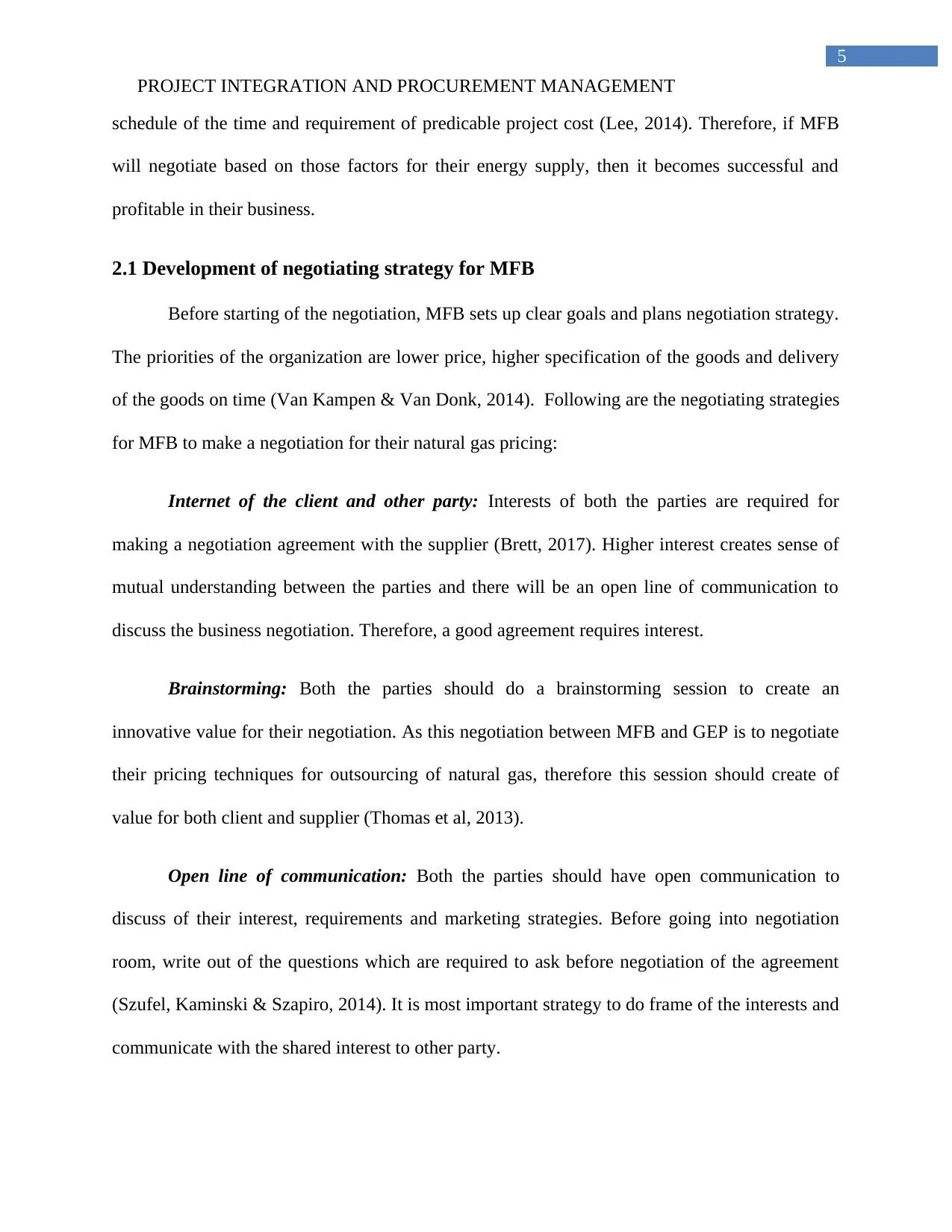
5
PROJECT INTEGRATION AND PROCUREMENT MANAGEMENT
schedule of the time and requirement of predicable project cost (Lee, 2014). Therefore, if MFB
will negotiate based on those factors for their energy supply, then it becomes successful and
profitable in their business.
2.1 Development of negotiating strategy for MFB
Before starting of the negotiation, MFB sets up clear goals and plans negotiation strategy.
The priorities of the organization are lower price, higher specification of the goods and delivery
of the goods on time (Van Kampen & Van Donk, 2014). Following are the negotiating strategies
for MFB to make a negotiation for their natural gas pricing:
Internet of the client and other party: Interests of both the parties are required for
making a negotiation agreement with the supplier (Brett, 2017). Higher interest creates sense of
mutual understanding between the parties and there will be an open line of communication to
discuss the business negotiation. Therefore, a good agreement requires interest.
Brainstorming: Both the parties should do a brainstorming session to create an
innovative value for their negotiation. As this negotiation between MFB and GEP is to negotiate
their pricing techniques for outsourcing of natural gas, therefore this session should create of
value for both client and supplier (Thomas et al, 2013).
Open line of communication: Both the parties should have open communication to
discuss of their interest, requirements and marketing strategies. Before going into negotiation
room, write out of the questions which are required to ask before negotiation of the agreement
(Szufel, Kaminski & Szapiro, 2014). It is most important strategy to do frame of the interests and
communicate with the shared interest to other party.
PROJECT INTEGRATION AND PROCUREMENT MANAGEMENT
schedule of the time and requirement of predicable project cost (Lee, 2014). Therefore, if MFB
will negotiate based on those factors for their energy supply, then it becomes successful and
profitable in their business.
2.1 Development of negotiating strategy for MFB
Before starting of the negotiation, MFB sets up clear goals and plans negotiation strategy.
The priorities of the organization are lower price, higher specification of the goods and delivery
of the goods on time (Van Kampen & Van Donk, 2014). Following are the negotiating strategies
for MFB to make a negotiation for their natural gas pricing:
Internet of the client and other party: Interests of both the parties are required for
making a negotiation agreement with the supplier (Brett, 2017). Higher interest creates sense of
mutual understanding between the parties and there will be an open line of communication to
discuss the business negotiation. Therefore, a good agreement requires interest.
Brainstorming: Both the parties should do a brainstorming session to create an
innovative value for their negotiation. As this negotiation between MFB and GEP is to negotiate
their pricing techniques for outsourcing of natural gas, therefore this session should create of
value for both client and supplier (Thomas et al, 2013).
Open line of communication: Both the parties should have open communication to
discuss of their interest, requirements and marketing strategies. Before going into negotiation
room, write out of the questions which are required to ask before negotiation of the agreement
(Szufel, Kaminski & Szapiro, 2014). It is most important strategy to do frame of the interests and
communicate with the shared interest to other party.
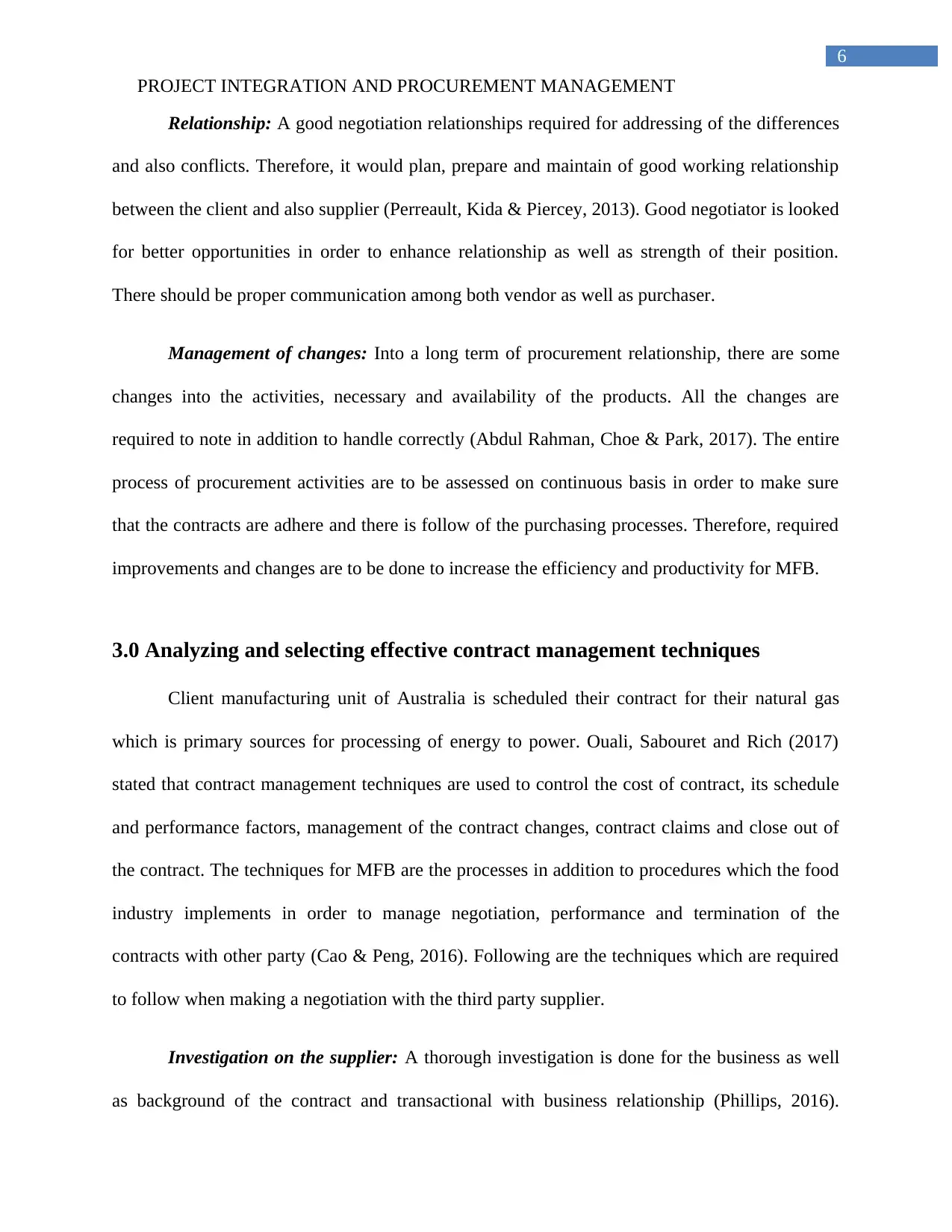
6
PROJECT INTEGRATION AND PROCUREMENT MANAGEMENT
Relationship: A good negotiation relationships required for addressing of the differences
and also conflicts. Therefore, it would plan, prepare and maintain of good working relationship
between the client and also supplier (Perreault, Kida & Piercey, 2013). Good negotiator is looked
for better opportunities in order to enhance relationship as well as strength of their position.
There should be proper communication among both vendor as well as purchaser.
Management of changes: Into a long term of procurement relationship, there are some
changes into the activities, necessary and availability of the products. All the changes are
required to note in addition to handle correctly (Abdul Rahman, Choe & Park, 2017). The entire
process of procurement activities are to be assessed on continuous basis in order to make sure
that the contracts are adhere and there is follow of the purchasing processes. Therefore, required
improvements and changes are to be done to increase the efficiency and productivity for MFB.
3.0 Analyzing and selecting effective contract management techniques
Client manufacturing unit of Australia is scheduled their contract for their natural gas
which is primary sources for processing of energy to power. Ouali, Sabouret and Rich (2017)
stated that contract management techniques are used to control the cost of contract, its schedule
and performance factors, management of the contract changes, contract claims and close out of
the contract. The techniques for MFB are the processes in addition to procedures which the food
industry implements in order to manage negotiation, performance and termination of the
contracts with other party (Cao & Peng, 2016). Following are the techniques which are required
to follow when making a negotiation with the third party supplier.
Investigation on the supplier: A thorough investigation is done for the business as well
as background of the contract and transactional with business relationship (Phillips, 2016).
PROJECT INTEGRATION AND PROCUREMENT MANAGEMENT
Relationship: A good negotiation relationships required for addressing of the differences
and also conflicts. Therefore, it would plan, prepare and maintain of good working relationship
between the client and also supplier (Perreault, Kida & Piercey, 2013). Good negotiator is looked
for better opportunities in order to enhance relationship as well as strength of their position.
There should be proper communication among both vendor as well as purchaser.
Management of changes: Into a long term of procurement relationship, there are some
changes into the activities, necessary and availability of the products. All the changes are
required to note in addition to handle correctly (Abdul Rahman, Choe & Park, 2017). The entire
process of procurement activities are to be assessed on continuous basis in order to make sure
that the contracts are adhere and there is follow of the purchasing processes. Therefore, required
improvements and changes are to be done to increase the efficiency and productivity for MFB.
3.0 Analyzing and selecting effective contract management techniques
Client manufacturing unit of Australia is scheduled their contract for their natural gas
which is primary sources for processing of energy to power. Ouali, Sabouret and Rich (2017)
stated that contract management techniques are used to control the cost of contract, its schedule
and performance factors, management of the contract changes, contract claims and close out of
the contract. The techniques for MFB are the processes in addition to procedures which the food
industry implements in order to manage negotiation, performance and termination of the
contracts with other party (Cao & Peng, 2016). Following are the techniques which are required
to follow when making a negotiation with the third party supplier.
Investigation on the supplier: A thorough investigation is done for the business as well
as background of the contract and transactional with business relationship (Phillips, 2016).
Paraphrase This Document
Need a fresh take? Get an instant paraphrase of this document with our AI Paraphraser
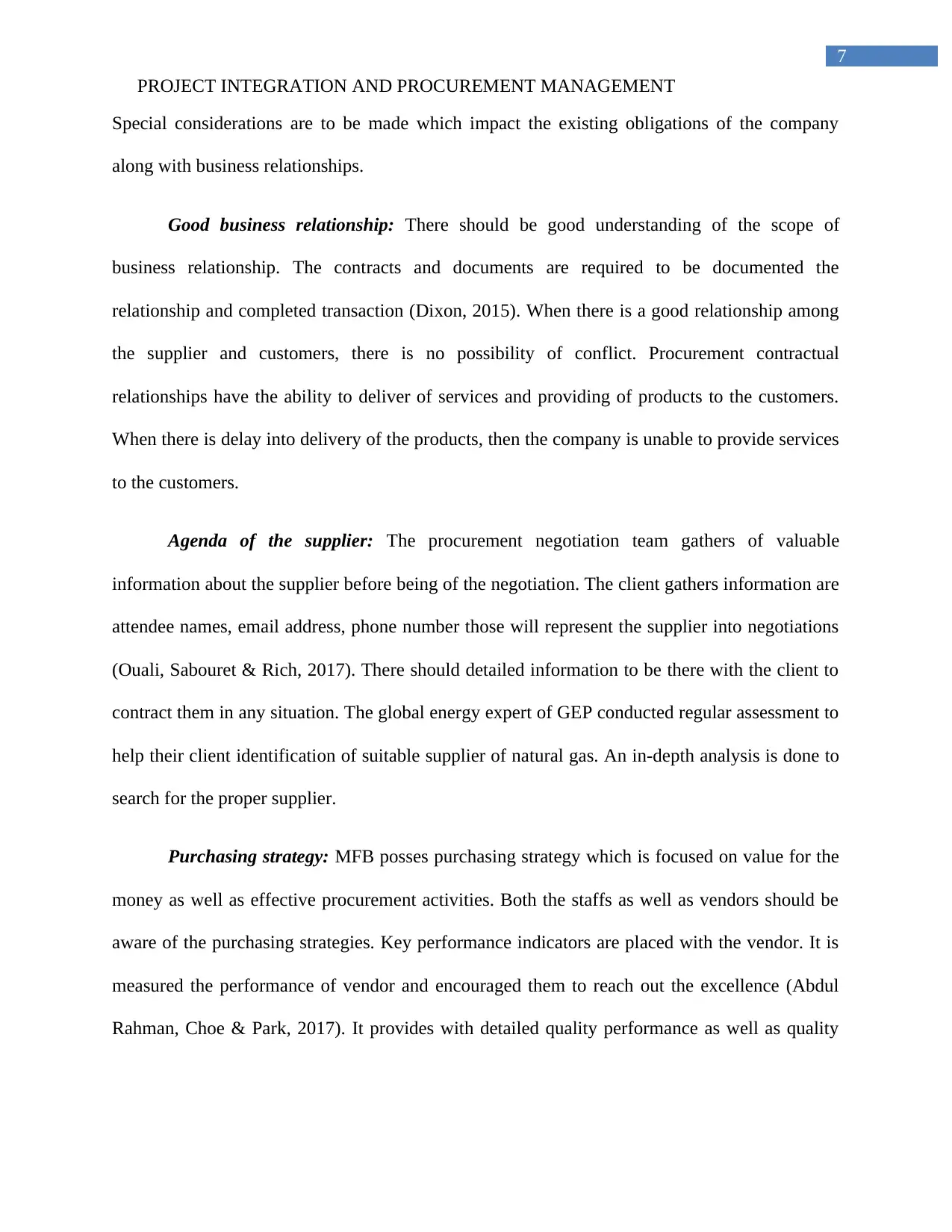
7
PROJECT INTEGRATION AND PROCUREMENT MANAGEMENT
Special considerations are to be made which impact the existing obligations of the company
along with business relationships.
Good business relationship: There should be good understanding of the scope of
business relationship. The contracts and documents are required to be documented the
relationship and completed transaction (Dixon, 2015). When there is a good relationship among
the supplier and customers, there is no possibility of conflict. Procurement contractual
relationships have the ability to deliver of services and providing of products to the customers.
When there is delay into delivery of the products, then the company is unable to provide services
to the customers.
Agenda of the supplier: The procurement negotiation team gathers of valuable
information about the supplier before being of the negotiation. The client gathers information are
attendee names, email address, phone number those will represent the supplier into negotiations
(Ouali, Sabouret & Rich, 2017). There should detailed information to be there with the client to
contract them in any situation. The global energy expert of GEP conducted regular assessment to
help their client identification of suitable supplier of natural gas. An in-depth analysis is done to
search for the proper supplier.
Purchasing strategy: MFB posses purchasing strategy which is focused on value for the
money as well as effective procurement activities. Both the staffs as well as vendors should be
aware of the purchasing strategies. Key performance indicators are placed with the vendor. It is
measured the performance of vendor and encouraged them to reach out the excellence (Abdul
Rahman, Choe & Park, 2017). It provides with detailed quality performance as well as quality
PROJECT INTEGRATION AND PROCUREMENT MANAGEMENT
Special considerations are to be made which impact the existing obligations of the company
along with business relationships.
Good business relationship: There should be good understanding of the scope of
business relationship. The contracts and documents are required to be documented the
relationship and completed transaction (Dixon, 2015). When there is a good relationship among
the supplier and customers, there is no possibility of conflict. Procurement contractual
relationships have the ability to deliver of services and providing of products to the customers.
When there is delay into delivery of the products, then the company is unable to provide services
to the customers.
Agenda of the supplier: The procurement negotiation team gathers of valuable
information about the supplier before being of the negotiation. The client gathers information are
attendee names, email address, phone number those will represent the supplier into negotiations
(Ouali, Sabouret & Rich, 2017). There should detailed information to be there with the client to
contract them in any situation. The global energy expert of GEP conducted regular assessment to
help their client identification of suitable supplier of natural gas. An in-depth analysis is done to
search for the proper supplier.
Purchasing strategy: MFB posses purchasing strategy which is focused on value for the
money as well as effective procurement activities. Both the staffs as well as vendors should be
aware of the purchasing strategies. Key performance indicators are placed with the vendor. It is
measured the performance of vendor and encouraged them to reach out the excellence (Abdul
Rahman, Choe & Park, 2017). It provides with detailed quality performance as well as quality
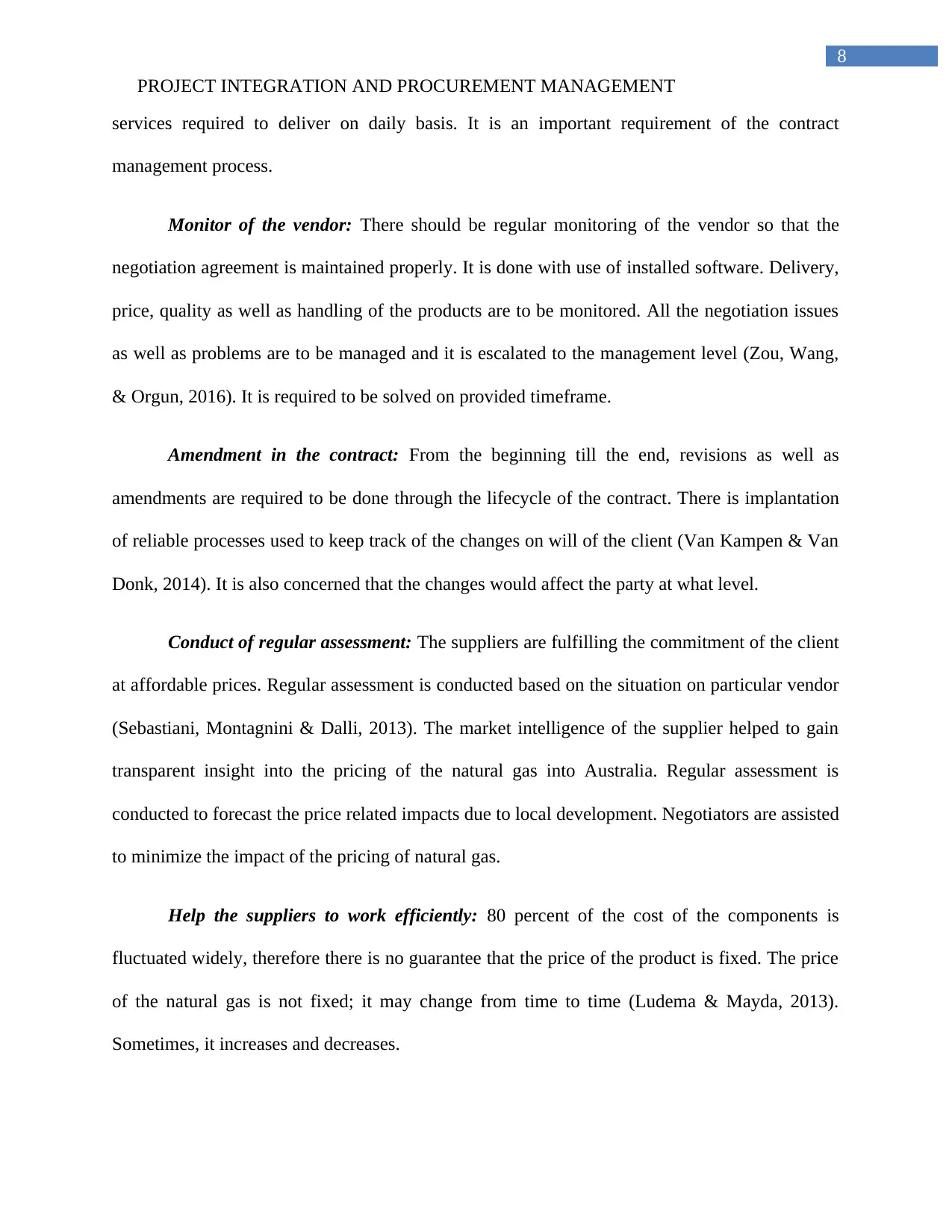
8
PROJECT INTEGRATION AND PROCUREMENT MANAGEMENT
services required to deliver on daily basis. It is an important requirement of the contract
management process.
Monitor of the vendor: There should be regular monitoring of the vendor so that the
negotiation agreement is maintained properly. It is done with use of installed software. Delivery,
price, quality as well as handling of the products are to be monitored. All the negotiation issues
as well as problems are to be managed and it is escalated to the management level (Zou, Wang,
& Orgun, 2016). It is required to be solved on provided timeframe.
Amendment in the contract: From the beginning till the end, revisions as well as
amendments are required to be done through the lifecycle of the contract. There is implantation
of reliable processes used to keep track of the changes on will of the client (Van Kampen & Van
Donk, 2014). It is also concerned that the changes would affect the party at what level.
Conduct of regular assessment: The suppliers are fulfilling the commitment of the client
at affordable prices. Regular assessment is conducted based on the situation on particular vendor
(Sebastiani, Montagnini & Dalli, 2013). The market intelligence of the supplier helped to gain
transparent insight into the pricing of the natural gas into Australia. Regular assessment is
conducted to forecast the price related impacts due to local development. Negotiators are assisted
to minimize the impact of the pricing of natural gas.
Help the suppliers to work efficiently: 80 percent of the cost of the components is
fluctuated widely, therefore there is no guarantee that the price of the product is fixed. The price
of the natural gas is not fixed; it may change from time to time (Ludema & Mayda, 2013).
Sometimes, it increases and decreases.
PROJECT INTEGRATION AND PROCUREMENT MANAGEMENT
services required to deliver on daily basis. It is an important requirement of the contract
management process.
Monitor of the vendor: There should be regular monitoring of the vendor so that the
negotiation agreement is maintained properly. It is done with use of installed software. Delivery,
price, quality as well as handling of the products are to be monitored. All the negotiation issues
as well as problems are to be managed and it is escalated to the management level (Zou, Wang,
& Orgun, 2016). It is required to be solved on provided timeframe.
Amendment in the contract: From the beginning till the end, revisions as well as
amendments are required to be done through the lifecycle of the contract. There is implantation
of reliable processes used to keep track of the changes on will of the client (Van Kampen & Van
Donk, 2014). It is also concerned that the changes would affect the party at what level.
Conduct of regular assessment: The suppliers are fulfilling the commitment of the client
at affordable prices. Regular assessment is conducted based on the situation on particular vendor
(Sebastiani, Montagnini & Dalli, 2013). The market intelligence of the supplier helped to gain
transparent insight into the pricing of the natural gas into Australia. Regular assessment is
conducted to forecast the price related impacts due to local development. Negotiators are assisted
to minimize the impact of the pricing of natural gas.
Help the suppliers to work efficiently: 80 percent of the cost of the components is
fluctuated widely, therefore there is no guarantee that the price of the product is fixed. The price
of the natural gas is not fixed; it may change from time to time (Ludema & Mayda, 2013).
Sometimes, it increases and decreases.
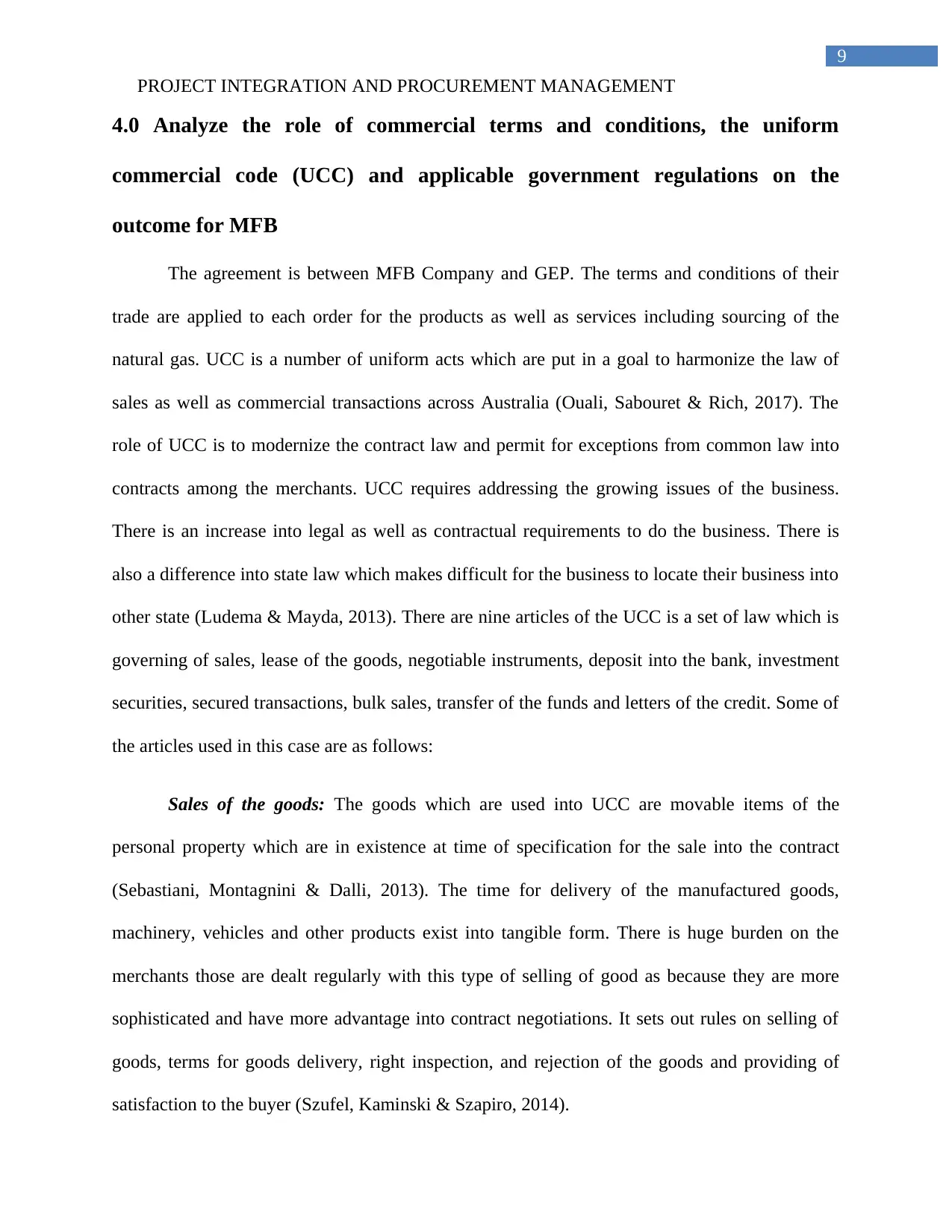
9
PROJECT INTEGRATION AND PROCUREMENT MANAGEMENT
4.0 Analyze the role of commercial terms and conditions, the uniform
commercial code (UCC) and applicable government regulations on the
outcome for MFB
The agreement is between MFB Company and GEP. The terms and conditions of their
trade are applied to each order for the products as well as services including sourcing of the
natural gas. UCC is a number of uniform acts which are put in a goal to harmonize the law of
sales as well as commercial transactions across Australia (Ouali, Sabouret & Rich, 2017). The
role of UCC is to modernize the contract law and permit for exceptions from common law into
contracts among the merchants. UCC requires addressing the growing issues of the business.
There is an increase into legal as well as contractual requirements to do the business. There is
also a difference into state law which makes difficult for the business to locate their business into
other state (Ludema & Mayda, 2013). There are nine articles of the UCC is a set of law which is
governing of sales, lease of the goods, negotiable instruments, deposit into the bank, investment
securities, secured transactions, bulk sales, transfer of the funds and letters of the credit. Some of
the articles used in this case are as follows:
Sales of the goods: The goods which are used into UCC are movable items of the
personal property which are in existence at time of specification for the sale into the contract
(Sebastiani, Montagnini & Dalli, 2013). The time for delivery of the manufactured goods,
machinery, vehicles and other products exist into tangible form. There is huge burden on the
merchants those are dealt regularly with this type of selling of good as because they are more
sophisticated and have more advantage into contract negotiations. It sets out rules on selling of
goods, terms for goods delivery, right inspection, and rejection of the goods and providing of
satisfaction to the buyer (Szufel, Kaminski & Szapiro, 2014).
PROJECT INTEGRATION AND PROCUREMENT MANAGEMENT
4.0 Analyze the role of commercial terms and conditions, the uniform
commercial code (UCC) and applicable government regulations on the
outcome for MFB
The agreement is between MFB Company and GEP. The terms and conditions of their
trade are applied to each order for the products as well as services including sourcing of the
natural gas. UCC is a number of uniform acts which are put in a goal to harmonize the law of
sales as well as commercial transactions across Australia (Ouali, Sabouret & Rich, 2017). The
role of UCC is to modernize the contract law and permit for exceptions from common law into
contracts among the merchants. UCC requires addressing the growing issues of the business.
There is an increase into legal as well as contractual requirements to do the business. There is
also a difference into state law which makes difficult for the business to locate their business into
other state (Ludema & Mayda, 2013). There are nine articles of the UCC is a set of law which is
governing of sales, lease of the goods, negotiable instruments, deposit into the bank, investment
securities, secured transactions, bulk sales, transfer of the funds and letters of the credit. Some of
the articles used in this case are as follows:
Sales of the goods: The goods which are used into UCC are movable items of the
personal property which are in existence at time of specification for the sale into the contract
(Sebastiani, Montagnini & Dalli, 2013). The time for delivery of the manufactured goods,
machinery, vehicles and other products exist into tangible form. There is huge burden on the
merchants those are dealt regularly with this type of selling of good as because they are more
sophisticated and have more advantage into contract negotiations. It sets out rules on selling of
goods, terms for goods delivery, right inspection, and rejection of the goods and providing of
satisfaction to the buyer (Szufel, Kaminski & Szapiro, 2014).
Secure Best Marks with AI Grader
Need help grading? Try our AI Grader for instant feedback on your assignments.
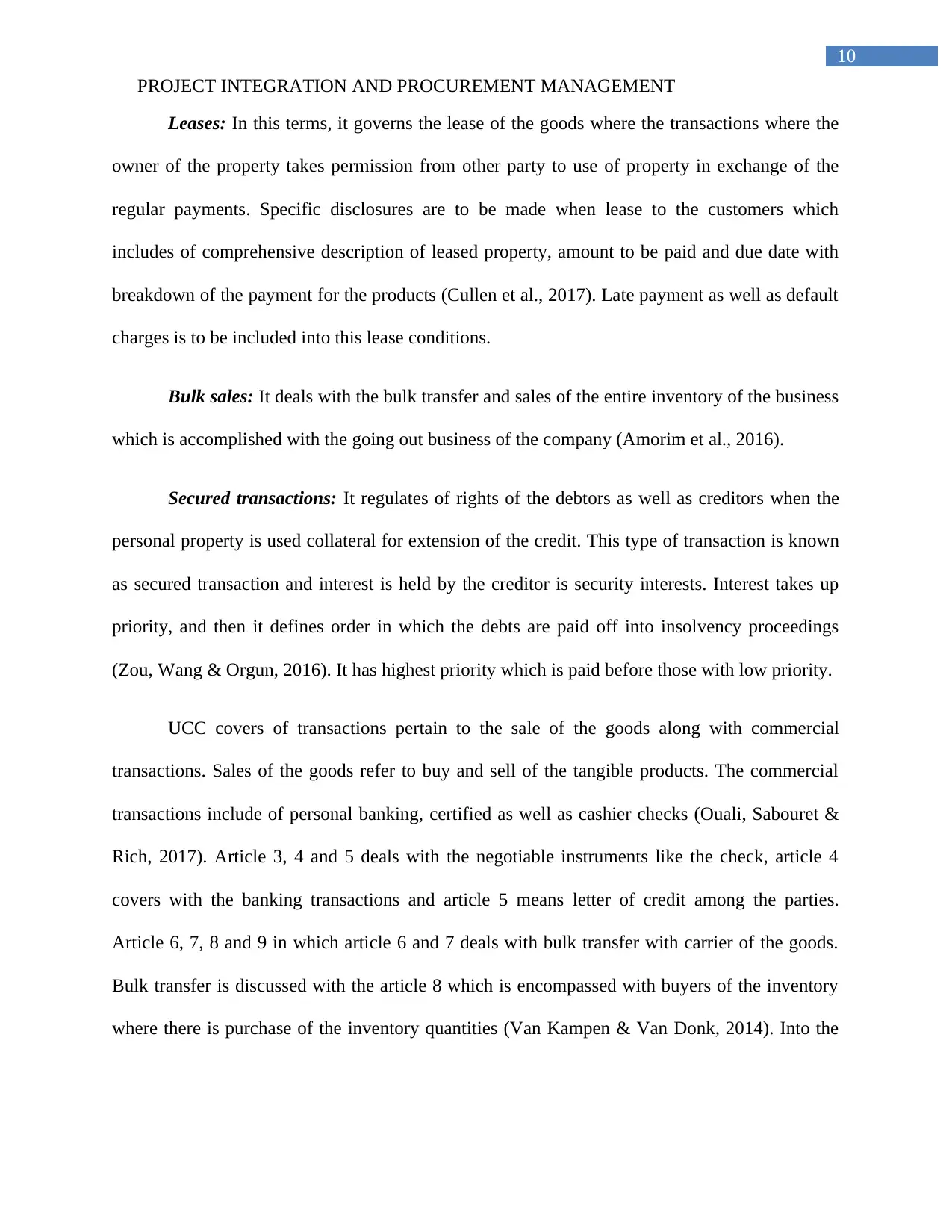
10
PROJECT INTEGRATION AND PROCUREMENT MANAGEMENT
Leases: In this terms, it governs the lease of the goods where the transactions where the
owner of the property takes permission from other party to use of property in exchange of the
regular payments. Specific disclosures are to be made when lease to the customers which
includes of comprehensive description of leased property, amount to be paid and due date with
breakdown of the payment for the products (Cullen et al., 2017). Late payment as well as default
charges is to be included into this lease conditions.
Bulk sales: It deals with the bulk transfer and sales of the entire inventory of the business
which is accomplished with the going out business of the company (Amorim et al., 2016).
Secured transactions: It regulates of rights of the debtors as well as creditors when the
personal property is used collateral for extension of the credit. This type of transaction is known
as secured transaction and interest is held by the creditor is security interests. Interest takes up
priority, and then it defines order in which the debts are paid off into insolvency proceedings
(Zou, Wang & Orgun, 2016). It has highest priority which is paid before those with low priority.
UCC covers of transactions pertain to the sale of the goods along with commercial
transactions. Sales of the goods refer to buy and sell of the tangible products. The commercial
transactions include of personal banking, certified as well as cashier checks (Ouali, Sabouret &
Rich, 2017). Article 3, 4 and 5 deals with the negotiable instruments like the check, article 4
covers with the banking transactions and article 5 means letter of credit among the parties.
Article 6, 7, 8 and 9 in which article 6 and 7 deals with bulk transfer with carrier of the goods.
Bulk transfer is discussed with the article 8 which is encompassed with buyers of the inventory
where there is purchase of the inventory quantities (Van Kampen & Van Donk, 2014). Into the
PROJECT INTEGRATION AND PROCUREMENT MANAGEMENT
Leases: In this terms, it governs the lease of the goods where the transactions where the
owner of the property takes permission from other party to use of property in exchange of the
regular payments. Specific disclosures are to be made when lease to the customers which
includes of comprehensive description of leased property, amount to be paid and due date with
breakdown of the payment for the products (Cullen et al., 2017). Late payment as well as default
charges is to be included into this lease conditions.
Bulk sales: It deals with the bulk transfer and sales of the entire inventory of the business
which is accomplished with the going out business of the company (Amorim et al., 2016).
Secured transactions: It regulates of rights of the debtors as well as creditors when the
personal property is used collateral for extension of the credit. This type of transaction is known
as secured transaction and interest is held by the creditor is security interests. Interest takes up
priority, and then it defines order in which the debts are paid off into insolvency proceedings
(Zou, Wang & Orgun, 2016). It has highest priority which is paid before those with low priority.
UCC covers of transactions pertain to the sale of the goods along with commercial
transactions. Sales of the goods refer to buy and sell of the tangible products. The commercial
transactions include of personal banking, certified as well as cashier checks (Ouali, Sabouret &
Rich, 2017). Article 3, 4 and 5 deals with the negotiable instruments like the check, article 4
covers with the banking transactions and article 5 means letter of credit among the parties.
Article 6, 7, 8 and 9 in which article 6 and 7 deals with bulk transfer with carrier of the goods.
Bulk transfer is discussed with the article 8 which is encompassed with buyers of the inventory
where there is purchase of the inventory quantities (Van Kampen & Van Donk, 2014). Into the
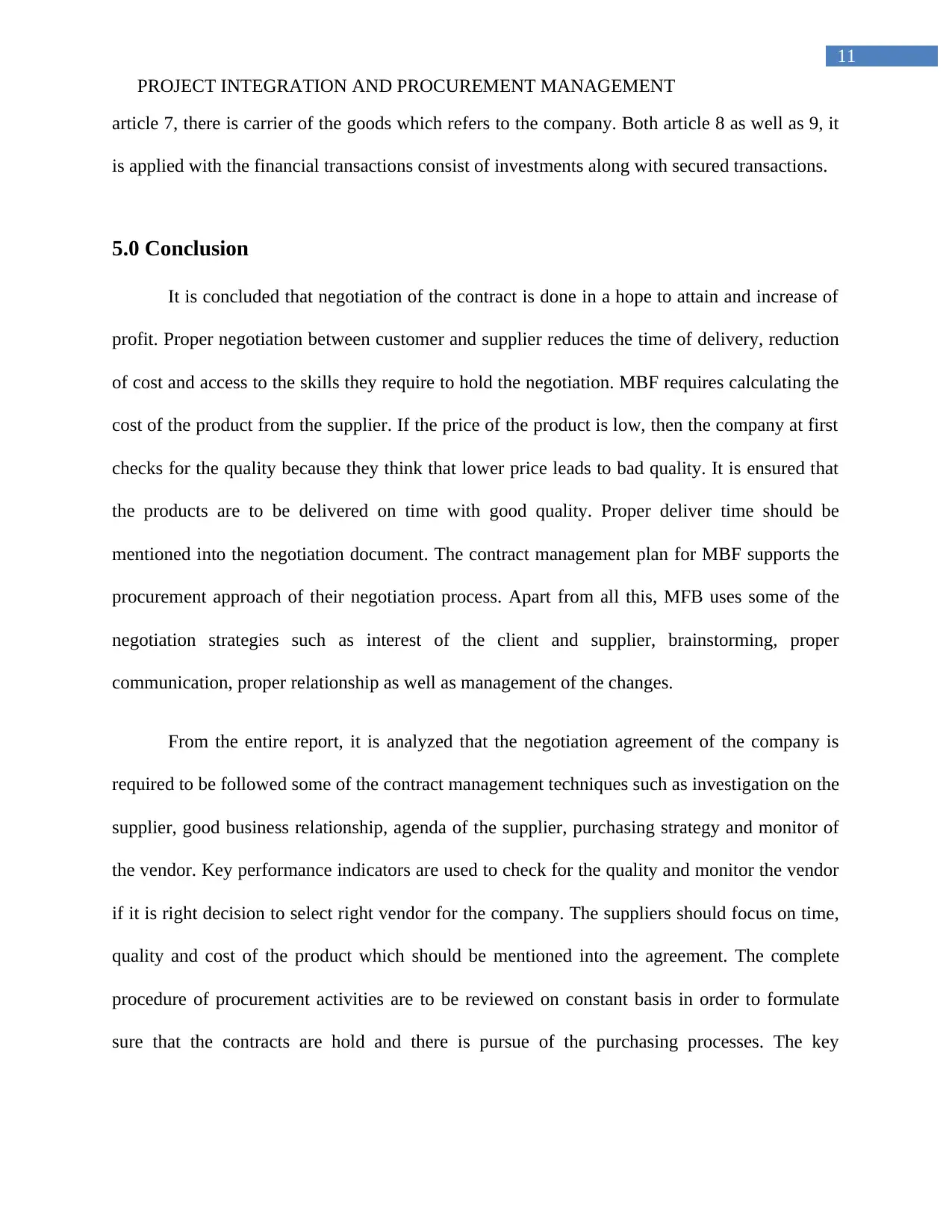
11
PROJECT INTEGRATION AND PROCUREMENT MANAGEMENT
article 7, there is carrier of the goods which refers to the company. Both article 8 as well as 9, it
is applied with the financial transactions consist of investments along with secured transactions.
5.0 Conclusion
It is concluded that negotiation of the contract is done in a hope to attain and increase of
profit. Proper negotiation between customer and supplier reduces the time of delivery, reduction
of cost and access to the skills they require to hold the negotiation. MBF requires calculating the
cost of the product from the supplier. If the price of the product is low, then the company at first
checks for the quality because they think that lower price leads to bad quality. It is ensured that
the products are to be delivered on time with good quality. Proper deliver time should be
mentioned into the negotiation document. The contract management plan for MBF supports the
procurement approach of their negotiation process. Apart from all this, MFB uses some of the
negotiation strategies such as interest of the client and supplier, brainstorming, proper
communication, proper relationship as well as management of the changes.
From the entire report, it is analyzed that the negotiation agreement of the company is
required to be followed some of the contract management techniques such as investigation on the
supplier, good business relationship, agenda of the supplier, purchasing strategy and monitor of
the vendor. Key performance indicators are used to check for the quality and monitor the vendor
if it is right decision to select right vendor for the company. The suppliers should focus on time,
quality and cost of the product which should be mentioned into the agreement. The complete
procedure of procurement activities are to be reviewed on constant basis in order to formulate
sure that the contracts are hold and there is pursue of the purchasing processes. The key
PROJECT INTEGRATION AND PROCUREMENT MANAGEMENT
article 7, there is carrier of the goods which refers to the company. Both article 8 as well as 9, it
is applied with the financial transactions consist of investments along with secured transactions.
5.0 Conclusion
It is concluded that negotiation of the contract is done in a hope to attain and increase of
profit. Proper negotiation between customer and supplier reduces the time of delivery, reduction
of cost and access to the skills they require to hold the negotiation. MBF requires calculating the
cost of the product from the supplier. If the price of the product is low, then the company at first
checks for the quality because they think that lower price leads to bad quality. It is ensured that
the products are to be delivered on time with good quality. Proper deliver time should be
mentioned into the negotiation document. The contract management plan for MBF supports the
procurement approach of their negotiation process. Apart from all this, MFB uses some of the
negotiation strategies such as interest of the client and supplier, brainstorming, proper
communication, proper relationship as well as management of the changes.
From the entire report, it is analyzed that the negotiation agreement of the company is
required to be followed some of the contract management techniques such as investigation on the
supplier, good business relationship, agenda of the supplier, purchasing strategy and monitor of
the vendor. Key performance indicators are used to check for the quality and monitor the vendor
if it is right decision to select right vendor for the company. The suppliers should focus on time,
quality and cost of the product which should be mentioned into the agreement. The complete
procedure of procurement activities are to be reviewed on constant basis in order to formulate
sure that the contracts are hold and there is pursue of the purchasing processes. The key

12
PROJECT INTEGRATION AND PROCUREMENT MANAGEMENT
performance indicators are used to check for the quality as well as monitor the vendor.
Performance is measured based on the timely delivery of the supplier to the client.
PROJECT INTEGRATION AND PROCUREMENT MANAGEMENT
performance indicators are used to check for the quality as well as monitor the vendor.
Performance is measured based on the timely delivery of the supplier to the client.
Paraphrase This Document
Need a fresh take? Get an instant paraphrase of this document with our AI Paraphraser
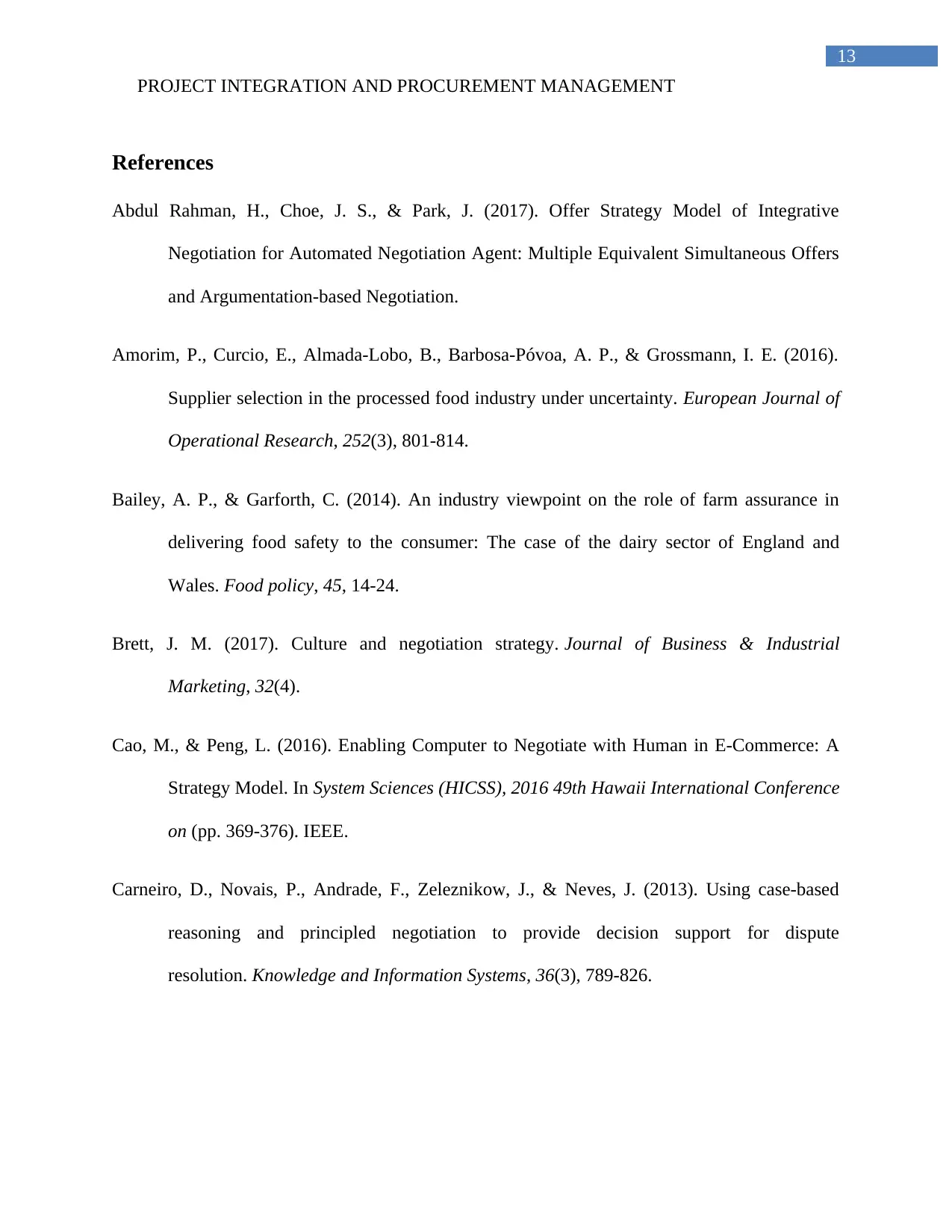
13
PROJECT INTEGRATION AND PROCUREMENT MANAGEMENT
References
Abdul Rahman, H., Choe, J. S., & Park, J. (2017). Offer Strategy Model of Integrative
Negotiation for Automated Negotiation Agent: Multiple Equivalent Simultaneous Offers
and Argumentation-based Negotiation.
Amorim, P., Curcio, E., Almada-Lobo, B., Barbosa-Póvoa, A. P., & Grossmann, I. E. (2016).
Supplier selection in the processed food industry under uncertainty. European Journal of
Operational Research, 252(3), 801-814.
Bailey, A. P., & Garforth, C. (2014). An industry viewpoint on the role of farm assurance in
delivering food safety to the consumer: The case of the dairy sector of England and
Wales. Food policy, 45, 14-24.
Brett, J. M. (2017). Culture and negotiation strategy. Journal of Business & Industrial
Marketing, 32(4).
Cao, M., & Peng, L. (2016). Enabling Computer to Negotiate with Human in E-Commerce: A
Strategy Model. In System Sciences (HICSS), 2016 49th Hawaii International Conference
on (pp. 369-376). IEEE.
Carneiro, D., Novais, P., Andrade, F., Zeleznikow, J., & Neves, J. (2013). Using case-based
reasoning and principled negotiation to provide decision support for dispute
resolution. Knowledge and Information Systems, 36(3), 789-826.
PROJECT INTEGRATION AND PROCUREMENT MANAGEMENT
References
Abdul Rahman, H., Choe, J. S., & Park, J. (2017). Offer Strategy Model of Integrative
Negotiation for Automated Negotiation Agent: Multiple Equivalent Simultaneous Offers
and Argumentation-based Negotiation.
Amorim, P., Curcio, E., Almada-Lobo, B., Barbosa-Póvoa, A. P., & Grossmann, I. E. (2016).
Supplier selection in the processed food industry under uncertainty. European Journal of
Operational Research, 252(3), 801-814.
Bailey, A. P., & Garforth, C. (2014). An industry viewpoint on the role of farm assurance in
delivering food safety to the consumer: The case of the dairy sector of England and
Wales. Food policy, 45, 14-24.
Brett, J. M. (2017). Culture and negotiation strategy. Journal of Business & Industrial
Marketing, 32(4).
Cao, M., & Peng, L. (2016). Enabling Computer to Negotiate with Human in E-Commerce: A
Strategy Model. In System Sciences (HICSS), 2016 49th Hawaii International Conference
on (pp. 369-376). IEEE.
Carneiro, D., Novais, P., Andrade, F., Zeleznikow, J., & Neves, J. (2013). Using case-based
reasoning and principled negotiation to provide decision support for dispute
resolution. Knowledge and Information Systems, 36(3), 789-826.
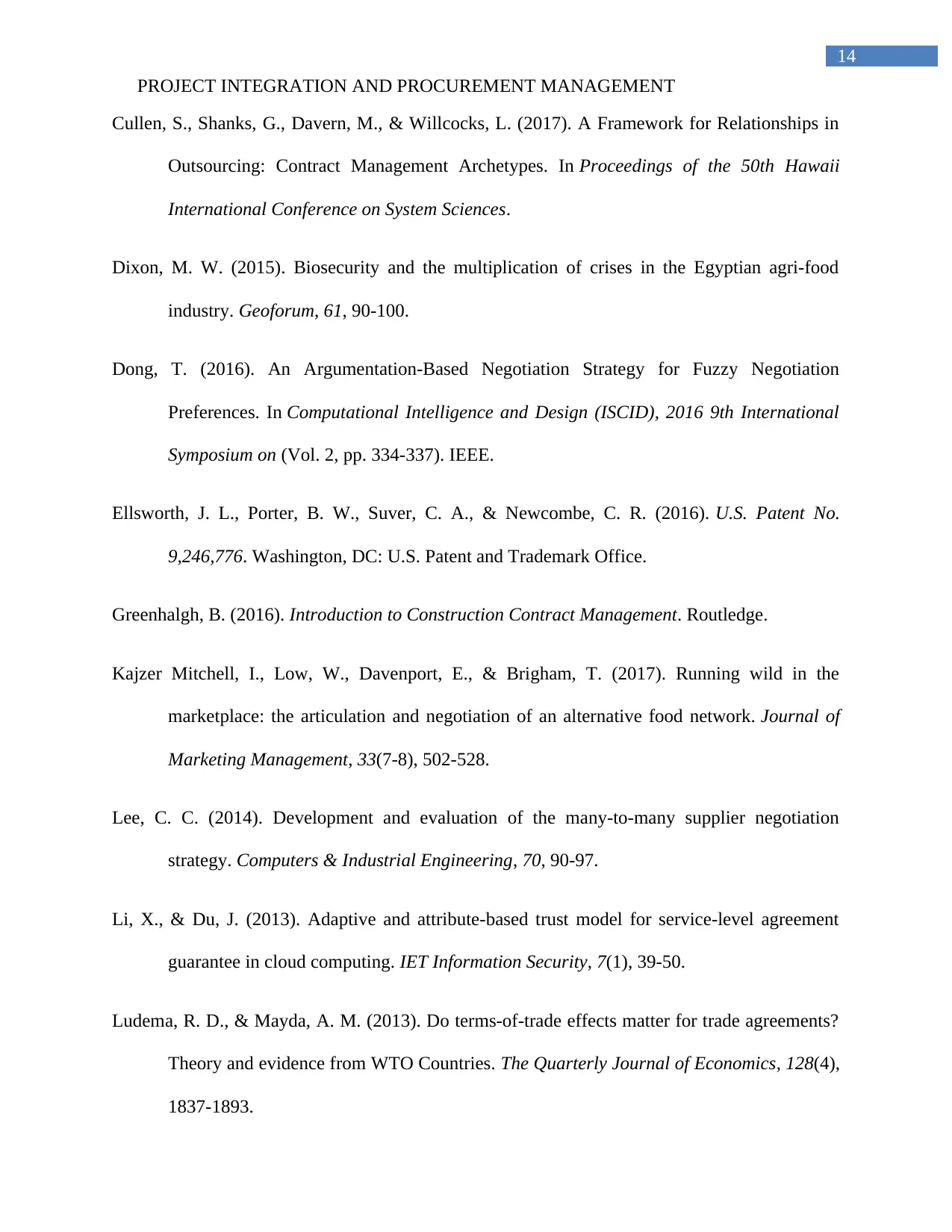
14
PROJECT INTEGRATION AND PROCUREMENT MANAGEMENT
Cullen, S., Shanks, G., Davern, M., & Willcocks, L. (2017). A Framework for Relationships in
Outsourcing: Contract Management Archetypes. In Proceedings of the 50th Hawaii
International Conference on System Sciences.
Dixon, M. W. (2015). Biosecurity and the multiplication of crises in the Egyptian agri-food
industry. Geoforum, 61, 90-100.
Dong, T. (2016). An Argumentation-Based Negotiation Strategy for Fuzzy Negotiation
Preferences. In Computational Intelligence and Design (ISCID), 2016 9th International
Symposium on (Vol. 2, pp. 334-337). IEEE.
Ellsworth, J. L., Porter, B. W., Suver, C. A., & Newcombe, C. R. (2016). U.S. Patent No.
9,246,776. Washington, DC: U.S. Patent and Trademark Office.
Greenhalgh, B. (2016). Introduction to Construction Contract Management. Routledge.
Kajzer Mitchell, I., Low, W., Davenport, E., & Brigham, T. (2017). Running wild in the
marketplace: the articulation and negotiation of an alternative food network. Journal of
Marketing Management, 33(7-8), 502-528.
Lee, C. C. (2014). Development and evaluation of the many-to-many supplier negotiation
strategy. Computers & Industrial Engineering, 70, 90-97.
Li, X., & Du, J. (2013). Adaptive and attribute-based trust model for service-level agreement
guarantee in cloud computing. IET Information Security, 7(1), 39-50.
Ludema, R. D., & Mayda, A. M. (2013). Do terms-of-trade effects matter for trade agreements?
Theory and evidence from WTO Countries. The Quarterly Journal of Economics, 128(4),
1837-1893.
PROJECT INTEGRATION AND PROCUREMENT MANAGEMENT
Cullen, S., Shanks, G., Davern, M., & Willcocks, L. (2017). A Framework for Relationships in
Outsourcing: Contract Management Archetypes. In Proceedings of the 50th Hawaii
International Conference on System Sciences.
Dixon, M. W. (2015). Biosecurity and the multiplication of crises in the Egyptian agri-food
industry. Geoforum, 61, 90-100.
Dong, T. (2016). An Argumentation-Based Negotiation Strategy for Fuzzy Negotiation
Preferences. In Computational Intelligence and Design (ISCID), 2016 9th International
Symposium on (Vol. 2, pp. 334-337). IEEE.
Ellsworth, J. L., Porter, B. W., Suver, C. A., & Newcombe, C. R. (2016). U.S. Patent No.
9,246,776. Washington, DC: U.S. Patent and Trademark Office.
Greenhalgh, B. (2016). Introduction to Construction Contract Management. Routledge.
Kajzer Mitchell, I., Low, W., Davenport, E., & Brigham, T. (2017). Running wild in the
marketplace: the articulation and negotiation of an alternative food network. Journal of
Marketing Management, 33(7-8), 502-528.
Lee, C. C. (2014). Development and evaluation of the many-to-many supplier negotiation
strategy. Computers & Industrial Engineering, 70, 90-97.
Li, X., & Du, J. (2013). Adaptive and attribute-based trust model for service-level agreement
guarantee in cloud computing. IET Information Security, 7(1), 39-50.
Ludema, R. D., & Mayda, A. M. (2013). Do terms-of-trade effects matter for trade agreements?
Theory and evidence from WTO Countries. The Quarterly Journal of Economics, 128(4),
1837-1893.
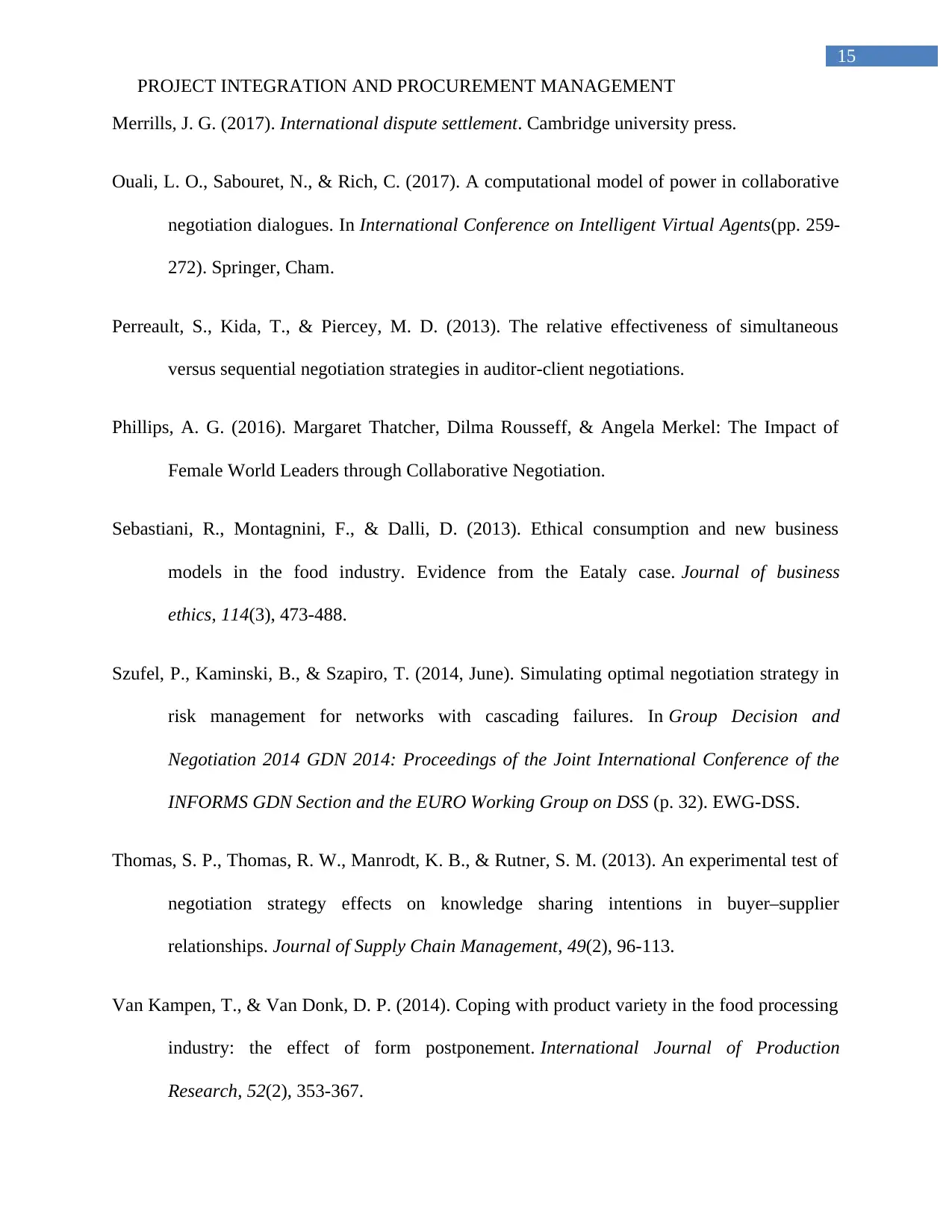
15
PROJECT INTEGRATION AND PROCUREMENT MANAGEMENT
Merrills, J. G. (2017). International dispute settlement. Cambridge university press.
Ouali, L. O., Sabouret, N., & Rich, C. (2017). A computational model of power in collaborative
negotiation dialogues. In International Conference on Intelligent Virtual Agents(pp. 259-
272). Springer, Cham.
Perreault, S., Kida, T., & Piercey, M. D. (2013). The relative effectiveness of simultaneous
versus sequential negotiation strategies in auditor-client negotiations.
Phillips, A. G. (2016). Margaret Thatcher, Dilma Rousseff, & Angela Merkel: The Impact of
Female World Leaders through Collaborative Negotiation.
Sebastiani, R., Montagnini, F., & Dalli, D. (2013). Ethical consumption and new business
models in the food industry. Evidence from the Eataly case. Journal of business
ethics, 114(3), 473-488.
Szufel, P., Kaminski, B., & Szapiro, T. (2014, June). Simulating optimal negotiation strategy in
risk management for networks with cascading failures. In Group Decision and
Negotiation 2014 GDN 2014: Proceedings of the Joint International Conference of the
INFORMS GDN Section and the EURO Working Group on DSS (p. 32). EWG-DSS.
Thomas, S. P., Thomas, R. W., Manrodt, K. B., & Rutner, S. M. (2013). An experimental test of
negotiation strategy effects on knowledge sharing intentions in buyer–supplier
relationships. Journal of Supply Chain Management, 49(2), 96-113.
Van Kampen, T., & Van Donk, D. P. (2014). Coping with product variety in the food processing
industry: the effect of form postponement. International Journal of Production
Research, 52(2), 353-367.
PROJECT INTEGRATION AND PROCUREMENT MANAGEMENT
Merrills, J. G. (2017). International dispute settlement. Cambridge university press.
Ouali, L. O., Sabouret, N., & Rich, C. (2017). A computational model of power in collaborative
negotiation dialogues. In International Conference on Intelligent Virtual Agents(pp. 259-
272). Springer, Cham.
Perreault, S., Kida, T., & Piercey, M. D. (2013). The relative effectiveness of simultaneous
versus sequential negotiation strategies in auditor-client negotiations.
Phillips, A. G. (2016). Margaret Thatcher, Dilma Rousseff, & Angela Merkel: The Impact of
Female World Leaders through Collaborative Negotiation.
Sebastiani, R., Montagnini, F., & Dalli, D. (2013). Ethical consumption and new business
models in the food industry. Evidence from the Eataly case. Journal of business
ethics, 114(3), 473-488.
Szufel, P., Kaminski, B., & Szapiro, T. (2014, June). Simulating optimal negotiation strategy in
risk management for networks with cascading failures. In Group Decision and
Negotiation 2014 GDN 2014: Proceedings of the Joint International Conference of the
INFORMS GDN Section and the EURO Working Group on DSS (p. 32). EWG-DSS.
Thomas, S. P., Thomas, R. W., Manrodt, K. B., & Rutner, S. M. (2013). An experimental test of
negotiation strategy effects on knowledge sharing intentions in buyer–supplier
relationships. Journal of Supply Chain Management, 49(2), 96-113.
Van Kampen, T., & Van Donk, D. P. (2014). Coping with product variety in the food processing
industry: the effect of form postponement. International Journal of Production
Research, 52(2), 353-367.
Secure Best Marks with AI Grader
Need help grading? Try our AI Grader for instant feedback on your assignments.
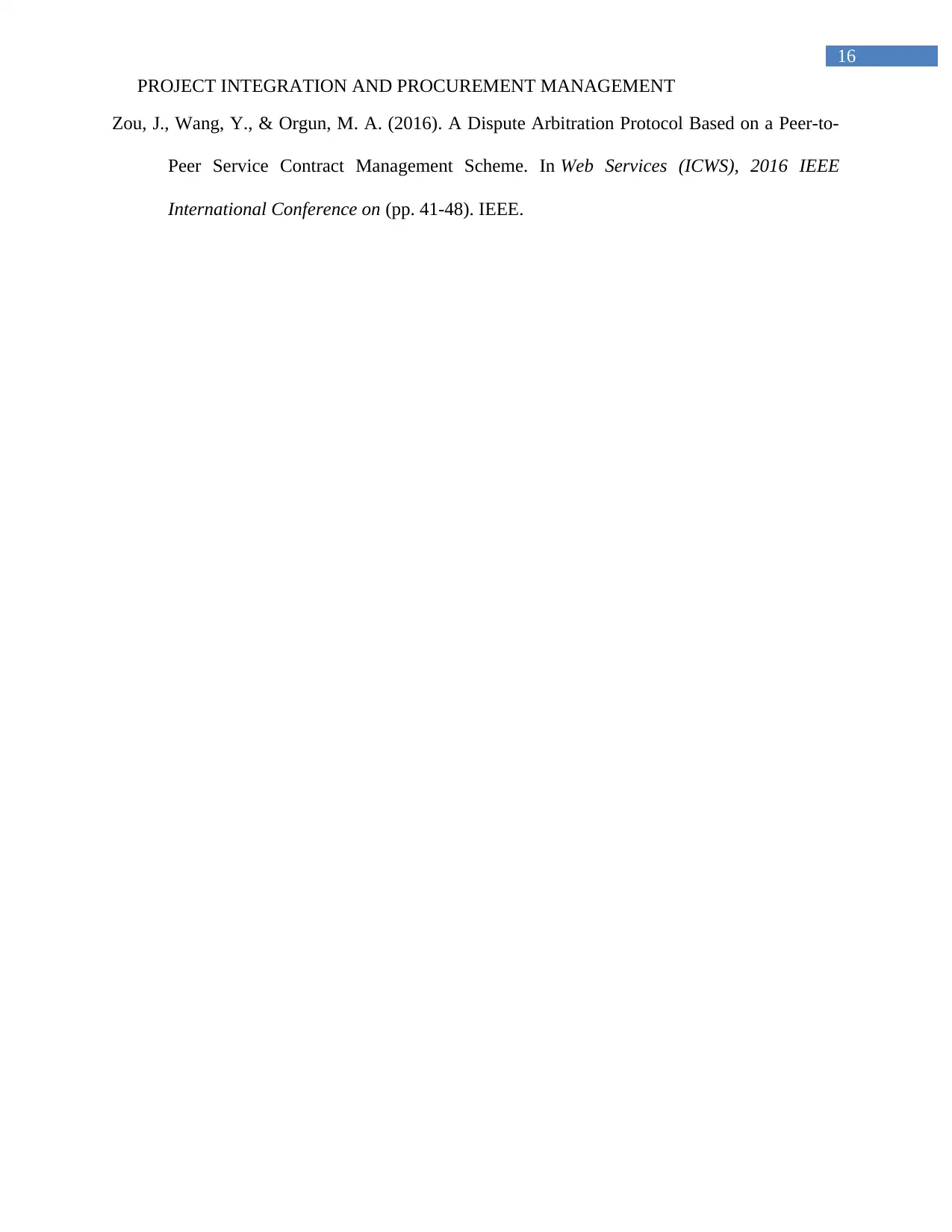
16
PROJECT INTEGRATION AND PROCUREMENT MANAGEMENT
Zou, J., Wang, Y., & Orgun, M. A. (2016). A Dispute Arbitration Protocol Based on a Peer-to-
Peer Service Contract Management Scheme. In Web Services (ICWS), 2016 IEEE
International Conference on (pp. 41-48). IEEE.
PROJECT INTEGRATION AND PROCUREMENT MANAGEMENT
Zou, J., Wang, Y., & Orgun, M. A. (2016). A Dispute Arbitration Protocol Based on a Peer-to-
Peer Service Contract Management Scheme. In Web Services (ICWS), 2016 IEEE
International Conference on (pp. 41-48). IEEE.
1 out of 17
Related Documents
Your All-in-One AI-Powered Toolkit for Academic Success.
+13062052269
info@desklib.com
Available 24*7 on WhatsApp / Email
![[object Object]](/_next/static/media/star-bottom.7253800d.svg)
Unlock your academic potential
© 2024 | Zucol Services PVT LTD | All rights reserved.





